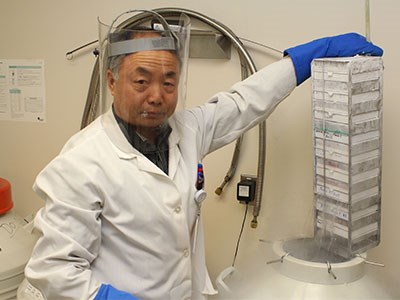A research team at Health Sciences North in Sudbury has developed a method that could see breast cancer treatments tailored to the particular genetic makeup of the patient.
The research has been promising enough to catch the attention of Toronto-based York Medtech Partners.
“We are a group that looks to form start-up companies from very promising technologies,” said Dr. Kenneth Pritzker, the investment firm's managing director.
In 2010, York Medtech Partners formed the company Rna Diagnostics to market the RNA Disruption Assay test developed at Health Sciences North.
Pritzker is the company's CEO. RNA stands for ribonucleic acid, large biological molecules that perform vital roles for the coding, decoding and regulation of genes.
“RNA is really the active component of genes,” said Dr. Amadeo Parissenti, Rna Diagnostics' chief scientific officer and the research lead in Sudbury.
“You can tell a lot about whether a gene is active or not based on whether there is RNA present for that particular gene.”
Parissenti and his team analyzed breast cancer tumour tissue samples, and discovered there is a correlation between the amount of RNA degradation and complete tumour destruction after treatment.
In other words, if a tissue sample had high-quality RNA after several rounds of chemotherapy, it meant the treatment was not very effective.
But a tissue sample with degraded, or disrupted RNA, after those same rounds of chemotherapy, meant the patient would be a good candidate to continue the therapy, since the tumour was being destroyed.
Those patients with high-quality RNA could forgo the toxic side-effects of continuing chemotherapy, and opt for surgery, radiation therapy, or other treatments instead.
Chemotherapy side-effects include a loss of blood cells, which makes patients more susceptible to infections.
A breast cancer patient will typically do six to eight rounds of chemotherapy to destroy the tumour. The Sudbury researchers have so far been able to conduct their RNA Disruption Assay test mid-treatment – at the third or fourth round of chemotherapy.
Parissenti said the hope is to eventually be able to conduct the test at the early stages of chemotherapy, so doctors can best respond to their patients' needs and choose the treatment that will work best for them.
Parissenti said the test could be conducted on other types of cancer, but they have started research with breast cancer because live tissue samples are more easily obtainable than with some other cancers.
His research also concluded that patients with a high tumour RNA disruption score lived about two to three-and-ahalf years longer cancer-free than patients with a high-quality RNA, following the completion of chemotherapy.
Dr. Roger Strasser, dean of the Northern Ontario School of Medicine, pulled no punches — he called the research a "breakthrough."
“I extend my sincere congratulations to Dr. Parissenti and his team for this important breakthrough,” Strasser said. Pritzker said Rna Diagnostics was able to secure $5 million in funding – split between public sources and private investors.
The $2.5 million in public investment included loans and grants from the Northern Ontario Heritage Fund Corporation, FedNor and a variety of provincial agencies.
The $2.5 million in private investment came from a number of angel investors, including some based in Northern Ontario, Pritzker said.
The company has already started to target markets in Europe, which Pritzker said has the potential to be a profitable jurisdiction for the venture. “This is a global business,” he said. “This is not something we're only providing for the North.”
The Sudbury research team is now working to automate the RNA Disruption Assay test and increase its efficiency.
Once the test is ready for the market, Pritzker said the lab in Sudbury will contract out its work to hospitals around the world. Hospitals will be able to send tissue samples from cancer patients so researchers in Sudbury can determine how they will react to chemotherapy.
If the company grows, Pritzker said they could open other labs to conduct the test.
Hospitals could choose to pay for each individual test, or make a population-based payment by estimating the number of tests it will require in a year.
Pritzker said the test could be offered to entire jurisdictions, and be covered by insurance plans, such as the Ontario Health Insurance Plan.
“With this test, and the guidance it provides, physicians have more options regarding the therapy of their patients,” Pritzker said.




